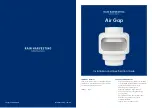
Lake Shore Model 370 AC Resistance Bridge User’s Manual
Analog Voltage Output Calibration (Continued)
10. Calculate the zero offset coefficient in percent as:
Coefficient = (–Voltage (0%)/10 V) × 100 = –Voltage (0%) × 10.
The zero offset should be between ±1%.
11. Send the zero offset coefficient to the appropriate output.
Analog Output 1:
CALZ 4,1,Coefficient
Analog Output 2:
CALZ 4,2,Coefficient
12. Repeat from Step 3 for the second analog output.
13. Send the CALSAVE command.
8.12.4
Heater Output Calibration
The Model 370 has 8 heater output current ranges. The heater output is calibrated with individual zero offset and gain
coefficients for each range. A DC voltmeter with accuracy of 1 mV on a 10 V range, resistors of known value from 20
Ω
to 60 k
Ω
and cable to connect to the heater output are required. Please note that calibration accuracy does not affect
closed loop control accuracy. Small errors in heater output accuracy are eliminated by the PID control equation.
Calculation of heater output power does depend on this calibration but it also depends on the heater resistance that is
entered into the instrument. Heater resistance is often difficult to measure because it changes with temperature and the
heater is often installed with small gauge lead wire.
To calibrate the heater output ranges perform the following sequence of operations.
1. Configure the Model 370 for Open Loop control. Refer to Paragraph 4.11.2.1.
2. Set the heater output to the highest range of 100 mA.
3. Set the heater calibration coefficients to their defaults of 0 and 1 with the following commands:
CALZ 3,1,0
and
CALG 3,1,1
4. Attach a nominal 20
Ω
resistor of known value across the heater output.
5. Set the Manual Output parameter value to 0%.
6. With a DVM read and record the voltage across the resistor as Voltage (0%).
7. Calculate the heater range zero offset coefficient in percent as:
Coefficient = (–Voltage (0%)/Actual Resistance)/(Nominal Current × 1.07) × 100.
The zero offset should be 0
±
1.0%.
8. Send the zero offset coefficient to the instrument with the following command:
CALZ 3,1, Coefficient
9. Change the Manual Output parameter value to 100%.
10. With a DVM read and record the voltage across the resistor as Voltage (100%).
11. Calculate the heater range gain coefficient as:
Coefficient = Nominal Current/(Voltage (100%)/Actual Resistance).
The gain should be 0.936 ±2%
12. End the gain coefficient to the instrument with the following command:
CALG 3,1, Coefficient
13. End the CALSAVE command and wait 10 seconds for the calibration to be saved in non-volatile memory.
(Alternatively this step can be done after all ranges are calibrated.)
14. Select the next lowest heater output range and repeat from Step 2 until all ranges are calibrated. Refer to the
worksheet below for resistor values and command forms.
Service
8-23
Содержание 370
Страница 22: ...Lake Shore Model 370 AC Resistance Bridge User s Manual 1 12 Introduction This Page Intentionally Left Blank ...
Страница 60: ...Lake Shore Model 370 AC Resistance Bridge User s Manual 3 16 Installation This Page Intentionally Left Blank ...
Страница 106: ...Lake Shore Model 370 AC Resistance Bridge User s Manual 5 12 Advanced Operation This Page Intentionally Left Blank ...
















































